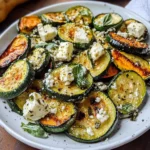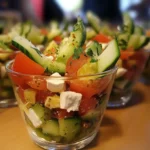After a long week of juggling work and family, finding a dinner that’s both satisfying and easy to whip up can feel like striking gold. This Vegetarian Lemon Herb Orzo recipe has become my absolute go-to for those evenings. From the moment the bright citrusy aroma fills the kitchen, it’s a signal of deliciousness to come. Even my picky eaters, who sometimes greet vegetables with skepticism, devour this dish with surprising enthusiasm. The fluffy orzo, infused with zesty lemon and fresh herbs, is incredibly versatile and comforting. Whether served warm as a main course or chilled as a vibrant side, this recipe has consistently delivered smiles around our dinner table. It’s proof that simple ingredients and minimal effort can create a truly flavorful and crowd-pleasing meal.
Ingredients for Easy Vegetarian Lemon Herb Orzo
- Orzo Pasta: (1 pound) The star of the dish, this rice-shaped pasta provides a delightful texture and absorbs flavors beautifully.
- Vegetable Broth: (6 cups) Forms the flavorful base for cooking the orzo, enhancing its taste beyond just water.
- Fresh Lemon: (2 large) Both zest and juice are used; the zest adds aromatic oils, while the juice provides bright acidity.
- Olive Oil: (1/4 cup) Essential for sautéing vegetables and adding richness to the dish. Opt for extra virgin for the best flavor.
- Garlic: (4 cloves) Minced garlic adds a pungent and savory depth that complements the lemon and herbs.
- Shallots: (2 medium) Finely chopped, shallots offer a milder, slightly sweet onion flavor compared to regular onions.
- Fresh Parsley: (1/2 cup, chopped) Provides a fresh, herbaceous note and vibrant green color. Flat-leaf parsley is recommended for its stronger flavor.
- Fresh Basil: (1/4 cup, chopped) Adds a sweet and slightly peppery aroma that pairs wonderfully with lemon and orzo.
- Fresh Dill: (1/4 cup, chopped) Contributes a unique, slightly tangy, and refreshing flavor to the herb blend.
- Parmesan Cheese: (1/2 cup, grated, optional) Adds a salty, umami richness and cheesy flavor. Can be omitted for a vegan version or substituted with nutritional yeast.
- Red Pepper Flakes: (1/2 teaspoon, optional) Provides a subtle warmth and a touch of spice to balance the citrus and herbs.
- Salt and Black Pepper: To taste, essential seasonings to enhance all the flavors in the dish.
Instructions for Making Vegetarian Lemon Herb Orzo
- Sauté Aromatics: Heat olive oil in a large pot or Dutch oven over medium heat. Add the finely chopped shallots and sauté for 3-4 minutes until softened and translucent. This step mellows out the shallots and releases their fragrant oils, creating a flavorful base for the dish. Be careful not to brown them; you just want them to become soft and aromatic.
- Add Garlic and Red Pepper Flakes (Optional): Stir in the minced garlic and red pepper flakes (if using) to the pot with the shallots. Sauté for another minute until the garlic becomes fragrant. Garlic burns easily, so keep the heat at medium and stir constantly during this step. The red pepper flakes will gently infuse the oil with a subtle heat.
- Toast the Orzo: Add the dry orzo pasta to the pot and toast it with the shallots and garlic for 2-3 minutes, stirring constantly. Toasting the orzo enhances its nutty flavor and helps it cook more evenly. You’ll notice a slight change in color and a toasted aroma.
- Pour in Vegetable Broth and Lemon Zest: Pour in the vegetable broth and add the zest of both lemons to the pot. Bring the mixture to a boil. The lemon zest infuses the broth and orzo with a bright citrusy aroma right from the start. Make sure to only zest the yellow part of the lemon, avoiding the bitter white pith.
- Simmer Orzo Until Cooked: Once boiling, reduce the heat to low, cover the pot, and simmer for 10-12 minutes, or until the orzo is cooked through and has absorbed most of the liquid. Stir occasionally to prevent sticking and ensure even cooking. The orzo should be tender but still slightly al dente.
- Stir in Lemon Juice and Herbs: Remove the pot from the heat. Stir in the fresh lemon juice, chopped fresh parsley, basil, and dill. The lemon juice adds a final burst of acidity and freshness, while the fresh herbs brighten the flavors and add aromatic complexity.
- Add Parmesan Cheese (Optional) and Season: If using Parmesan cheese, stir it into the orzo until melted and creamy. Season generously with salt and freshly ground black pepper to taste. Taste and adjust seasonings as needed; you may want to add more lemon juice, salt, or pepper to achieve your desired flavor profile.
- Let Rest and Serve: Let the orzo rest for a few minutes before serving. This allows the flavors to meld together and the orzo to absorb any remaining liquid. Serve hot, warm, or at room temperature, garnished with extra fresh herbs or lemon wedges if desired.
Nutrition Facts for Vegetarian Lemon Herb Orzo
Servings: 6
Calories per Serving: Approximately 350 kcal
- Total Fat: 12g (This includes healthy fats from olive oil)
- Saturated Fat: 2g (Primarily from optional Parmesan cheese)
- Cholesterol: 5mg (Minimal, primarily from optional Parmesan cheese)
Note: Nutritional values are estimates and can vary based on specific ingredients and portion sizes. Values are approximate and intended as a general guide.
Preparation Time for Easy Vegetarian Lemon Herb Orzo
Prep Time: 15 minutes
- This includes chopping shallots, garlic, and fresh herbs, zesting and juicing lemons, and measuring out ingredients. The prep work is straightforward and quick, making this a great weeknight meal option.
Cook Time: 20 minutes
- The orzo cooks relatively quickly in vegetable broth. The majority of the cooking time is simmering the orzo until it’s tender and has absorbed the liquid.
Total Time: 35 minutes
- From start to finish, this recipe is ready in under 40 minutes, making it a fantastic choice for a flavorful and speedy vegetarian meal. It’s perfect for busy weeknights or when you need a delicious dish without spending hours in the kitchen.
How to Serve Vegetarian Lemon Herb Orzo
- Warm Main Course: Serve immediately as a comforting and flavorful vegetarian main dish. It’s substantial enough to be satisfying on its own, especially with the addition of Parmesan cheese.
- Chilled Pasta Salad: Allow the orzo to cool completely and serve as a refreshing pasta salad. It’s perfect for picnics, potlucks, or summer gatherings. The lemon and herbs make it particularly bright and flavorful when served cold.
- Side Dish for Grilled Vegetables or Protein: Pair it as a vibrant side dish with grilled vegetables like zucchini, bell peppers, or asparagus. It also complements grilled halloumi cheese or tofu for a complete vegetarian meal. If serving to non-vegetarians, it pairs well with grilled chicken or fish.
- Mixed with Roasted Vegetables: Toss the cooked orzo with roasted vegetables such as broccoli, Brussels sprouts, or cherry tomatoes for added texture and flavor. Roasting vegetables intensifies their sweetness and provides a nice contrast to the lemony orzo.
- Base for a Bowl Meal: Use it as a base for a nourishing bowl meal. Top with chickpeas, white beans, or lentils for added protein, and roasted vegetables or a dollop of hummus for extra flavor and nutrients.
- Lunchbox Staple: Pack it in lunchboxes for a flavorful and satisfying vegetarian lunch. It holds up well and tastes great even when eaten at room temperature.
- Elegant Appetizer: Serve small portions of the orzo as an elegant and flavorful appetizer at a dinner party. Garnish with a sprig of fresh herbs or a lemon twist for visual appeal.
Additional Tips for Perfect Lemon Herb Orzo
- Don’t Overcook the Orzo: Cook the orzo until it’s al dente – tender but with a slight bite. Overcooked orzo can become mushy and lose its pleasant texture. Follow the cooking time guidelines and test for doneness a minute or two before the suggested time.
- Use Fresh, High-Quality Herbs: Fresh herbs are crucial for the vibrant flavor of this dish. Dried herbs won’t provide the same brightness and aroma. If you must substitute, use about one-third the amount of dried herbs compared to fresh.
- Zest the Lemon Before Juicing: Always zest the lemon before juicing it. It’s much easier to zest a whole lemon than a juiced one. Use a microplane or fine grater to get the zest without the bitter white pith.
- Taste and Adjust Seasoning: Seasoning is key to bringing out the flavors. Taste the orzo throughout the cooking process and adjust salt, pepper, and lemon juice as needed. A final taste and adjustment right before serving is crucial.
- Add Vegetables for Extra Nutrients: Feel free to add other vegetables to the orzo for added nutrients and flavor. Spinach, peas, asparagus, or sun-dried tomatoes would all be delicious additions. Add them towards the end of cooking so they retain some texture and freshness.
- Make it Vegan: To make this recipe vegan, simply omit the Parmesan cheese or substitute it with nutritional yeast for a cheesy, umami flavor. Ensure you are using vegetable broth that is certified vegan.
- Make Ahead and Reheat: This orzo can be made ahead of time and reheated. Store it in an airtight container in the refrigerator for up to 3 days. To reheat, add a splash of vegetable broth or water to loosen it up and microwave or gently warm on the stovetop.
- Get Creative with Herbs: While parsley, basil, and dill are classic choices, feel free to experiment with other fresh herbs like mint, chives, or oregano. A combination of your favorite herbs can create a unique flavor profile.
Frequently Asked Questions About Vegetarian Lemon Herb Orzo (FAQ)
Q1: Can I use chicken broth instead of vegetable broth?
A1: While this recipe is designed to be vegetarian using vegetable broth, you can substitute chicken broth if you are not strictly vegetarian. However, vegetable broth keeps the dish light and allows the lemon and herb flavors to shine through more distinctly. For a truly vegetarian dish, stick with vegetable broth.
Q2: Can I make this recipe gluten-free?
A2: Yes, you can easily make this recipe gluten-free by using gluten-free orzo pasta. Many brands offer gluten-free orzo made from rice or corn. Just ensure you check the packaging to confirm it is certified gluten-free if needed. All other ingredients in the recipe are naturally gluten-free.
Q3: Can I add protein to this orzo dish to make it a more substantial meal?
A3: Absolutely! Adding protein is a great way to make this orzo even more satisfying. Good vegetarian protein options include chickpeas, white beans, lentils, tofu (cubed and pan-fried or baked), or edamame. You can stir these in after the orzo is cooked or serve them on top. For non-vegetarian options, grilled chicken, shrimp, or fish would also pair well.
Q4: How long does leftover lemon herb orzo last in the refrigerator?
A4: Leftover lemon herb orzo will last for up to 3 days in an airtight container in the refrigerator. Make sure to cool it down to room temperature before refrigerating. When reheating, you may need to add a splash of vegetable broth or water to restore its moisture, as orzo can absorb liquid as it sits.
Q5: Can I freeze this orzo recipe?
A5: Freezing cooked orzo is not generally recommended as the texture can become slightly mushy upon thawing. However, if you need to freeze it, allow it to cool completely, then freeze in an airtight container for up to 1 month. Thaw overnight in the refrigerator and reheat gently, adding a bit of liquid if needed. The texture might be slightly different from freshly made orzo.
Q6: I don’t have shallots; can I use onions instead?
A6: Yes, you can substitute shallots with yellow or white onion. Onions have a stronger flavor than shallots, so use about half the amount (1 medium onion instead of 2 shallots). Finely chop the onion and sauté it similarly to the shallots until softened.
Q7: Can I use dried herbs if I don’t have fresh ones?
A7: While fresh herbs are highly recommended for the best flavor, you can use dried herbs in a pinch. Use about one-third the amount of dried herbs compared to fresh. For example, if the recipe calls for 1/2 cup of fresh parsley, use about 2 tablespoons of dried parsley. Add dried herbs earlier in the cooking process to allow them to rehydrate and release their flavor.
Q8: What are some good variations of this recipe?
A8: There are many ways to adapt this recipe! You can add different vegetables like roasted red peppers, artichoke hearts, or olives. For a creamy version, stir in a spoonful of cream cheese or mascarpone cheese at the end. You can also add a sprinkle of toasted pine nuts or breadcrumbs for texture. Experiment with different cheeses like feta or goat cheese instead of Parmesan. The possibilities are endless – get creative and make it your own!
Print
Easy Vegetarian Lemon Herb Orzo
Ingredients
- Orzo Pasta: (1 pound) The star of the dish, this rice-shaped pasta provides a delightful texture and absorbs flavors beautifully.
- Vegetable Broth: (6 cups) Forms the flavorful base for cooking the orzo, enhancing its taste beyond just water.
- Fresh Lemon: (2 large) Both zest and juice are used; the zest adds aromatic oils, while the juice provides bright acidity.
- Olive Oil: (1/4 cup) Essential for sautéing vegetables and adding richness to the dish. Opt for extra virgin for the best flavor.
- Garlic: (4 cloves) Minced garlic adds a pungent and savory depth that complements the lemon and herbs.
- Shallots: (2 medium) Finely chopped, shallots offer a milder, slightly sweet onion flavor compared to regular onions.
- Fresh Parsley: (1/2 cup, chopped) Provides a fresh, herbaceous note and vibrant green color. Flat-leaf parsley is recommended for its stronger flavor.
- Fresh Basil: (1/4 cup, chopped) Adds a sweet and slightly peppery aroma that pairs wonderfully with lemon and orzo.
- Fresh Dill: (1/4 cup, chopped) Contributes a unique, slightly tangy, and refreshing flavor to the herb blend.
- Parmesan Cheese: (1/2 cup, grated, optional) Adds a salty, umami richness and cheesy flavor. Can be omitted for a vegan version or substituted with nutritional yeast.
- Red Pepper Flakes: (1/2 teaspoon, optional) Provides a subtle warmth and a touch of spice to balance the citrus and herbs.
- Salt and Black Pepper: To taste, essential seasonings to enhance all the flavors in the dish.
Instructions
- Sauté Aromatics: Heat olive oil in a large pot or Dutch oven over medium heat. Add the finely chopped shallots and sauté for 3-4 minutes until softened and translucent. This step mellows out the shallots and releases their fragrant oils, creating a flavorful base for the dish. Be careful not to brown them; you just want them to become soft and aromatic.
- Add Garlic and Red Pepper Flakes (Optional): Stir in the minced garlic and red pepper flakes (if using) to the pot with the shallots. Sauté for another minute until the garlic becomes fragrant. Garlic burns easily, so keep the heat at medium and stir constantly during this step. The red pepper flakes will gently infuse the oil with a subtle heat.
- Toast the Orzo: Add the dry orzo pasta to the pot and toast it with the shallots and garlic for 2-3 minutes, stirring constantly. Toasting the orzo enhances its nutty flavor and helps it cook more evenly. You’ll notice a slight change in color and a toasted aroma.
- Pour in Vegetable Broth and Lemon Zest: Pour in the vegetable broth and add the zest of both lemons to the pot. Bring the mixture to a boil. The lemon zest infuses the broth and orzo with a bright citrusy aroma right from the start. Make sure to only zest the yellow part of the lemon, avoiding the bitter white pith.
- Simmer Orzo Until Cooked: Once boiling, reduce the heat to low, cover the pot, and simmer for 10-12 minutes, or until the orzo is cooked through and has absorbed most of the liquid. Stir occasionally to prevent sticking and ensure even cooking. The orzo should be tender but still slightly al dente.
- Stir in Lemon Juice and Herbs: Remove the pot from the heat. Stir in the fresh lemon juice, chopped fresh parsley, basil, and dill. The lemon juice adds a final burst of acidity and freshness, while the fresh herbs brighten the flavors and add aromatic complexity.
- Add Parmesan Cheese (Optional) and Season: If using Parmesan cheese, stir it into the orzo until melted and creamy. Season generously with salt and freshly ground black pepper to taste. Taste and adjust seasonings as needed; you may want to add more lemon juice, salt, or pepper to achieve your desired flavor profile.
- Let Rest and Serve: Let the orzo rest for a few minutes before serving. This allows the flavors to meld together and the orzo to absorb any remaining liquid. Serve hot, warm, or at room temperature, garnished with extra fresh herbs or lemon wedges if desired.
Nutrition
- Serving Size: one normal portion
- Calories: 350
- Fat: 12g
- Saturated Fat: 2g
- Cholesterol: 5mg






